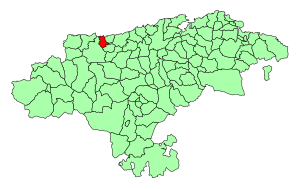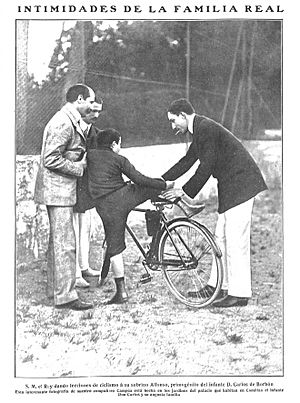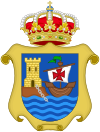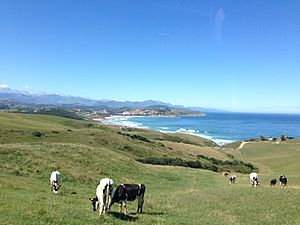Comillas facts for kids
Quick facts for kids
Comillas
|
|||
|---|---|---|---|

Aerial view of Comillas
|
|||
|
|||

Location in Cantabria
|
|||
| Country | |||
| Autonomous community | |||
| Province | Cantabria | ||
| Comarca | Western coast of Cantabria | ||
| Judicial district | San Vicente de la Barquera | ||
| Capital | Comillas | ||
| Area | |||
| • Total | 18.61 km2 (7.19 sq mi) | ||
| Elevation | 23 m (75 ft) | ||
| Highest elevation | 210 m (690 ft) | ||
| Lowest elevation | 0 m (0 ft) | ||
| Population
(2018)
|
|||
| • Total | 2,156 | ||
| • Density | 115.85/km2 (300.05/sq mi) | ||
| Demonym(s) | Comillano, na | ||
| Time zone | UTC+1 (CET) | ||
| • Summer (DST) | UTC+2 (CEST) | ||
Comillas is a small town and municipality located in northern Spain. It is part of the region called Cantabria. This town is known for its beautiful old buildings and rich history.
For a long time, Comillas was a popular summer spot for the Spanish royal family and many noble families. Because of this, you can see many grand palaces and monuments here. Some of these were designed by famous artists from Catalonia, like Antoni Gaudí and Lluís Domènech i Montaner.
Comillas even became the capital of Spain for one day on August 6, 1881! This happened when King Alfonso XII and his ministers held an important meeting in the town. Also, Comillas was the first place in Spain to use Edison's electric light bulbs, back in 1880.
Contents
History of Comillas
Comillas has a very long history. People first lived here in prehistoric times, using the many caves as shelters. They left behind rock paintings showing the animals they hunted. Tools and Roman coins have also been found in nearby areas. This shows that ancient people lived here and traded with others.
In the Middle Ages, Comillas was known as the "Town of the Bishops." This is because five priests born here later became bishops in different places. The town also has remains of old castles. One famous person, Garcilaso de la Vega, built a tower on the coast. This showed the town's importance in sea trade.
During the late 1800s, Comillas became very popular. The first Marquess of Comillas, Antonio López y López, invited King Alfonso XII to his mansion. This made the town a fashionable place for important families to spend their summers. A famous architect named Joan Martorell built the huge Palacio de Sobrellano for the Marquess.

Geography of Comillas
Comillas is located near the coast in the Cantabria region of Spain. To the north, you'll find the Bay of Biscay. To the south are the Cantabrian Mountains, which run along the coast. The highest point in these mountains is the Torre de Cerredo, which is 2,648 meters (8,688 feet) tall. The city of Santander is about 50 kilometers (31 miles) to the east. Comillas has a sandy beach and rocky areas, and the town itself is set a little back from the sea.
Famous Buildings in Comillas
Comillas is full of interesting buildings. In the oldest part of town, you'll find the Plaza del Corro de Campios. This square is surrounded by old mansions that have family shields on their walls. These shields show which noble families used to live there.
Nearby are the town hall and the San Cristóbal church, which was built in the 1600s. The cemetery also has some interesting old tombs. One of the most striking sights is the Neo-Gothic university buildings, which stand high above the town.
Comillas is especially famous for its Art Nouveau buildings. These include:
- The Sobrellano Palace Chapel
- The Pantheon
- El Capricho, a truly amazing building designed by the Catalan architect Antoni Gaudí.
The Marquess of Comillas
A Marquess is a noble title, like a Duke or Count. The first Marquess of Comillas was Antonio López y López. He was born in Comillas in 1817. He became very wealthy from his businesses in Cuba, especially in shipping. He bought the title of Marquess in 1878.
After Antonio López y López passed away in 1883, his son Claudio López Bru became the second Marquess. Today, the current Marquess of Comillas is Don Juan Alfonso Güell y Martos.
Gallery
-
El Capricho, a building by Antoni Gaudí
See also
 In Spanish: Comillas (Cantabria) para niños
In Spanish: Comillas (Cantabria) para niños

















